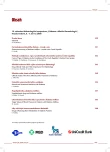Importance of the Structure of Insulin Preparations for Clinical Practice
Authors:
Š. Svačina
Authors‘ workplace:
III. interní klinika 1. lékařské fakulty UK a VFN Praha, přednosta prof. MUDr. Štěpán Svačina, DrSc., MBA
Published in:
Vnitř Lék 2009; 55(4): 409-411
Category:
Overview
Since the first application of insulin in the 1920s, many clinically necessary changes in the insulin action, effect reduction and extension, hypoglycemia risk reduction and positive weight development have been achieved by way of technological changes of insulin preparations. Such results have been achieved, in particular, by replacing insulin with insulin analogues. The impact on diabetes compensation and on the prevention of complications is not achieved by individual preparations but, in particular, by the quality of treatment and cooperation from the patient. The doctor should know, in particular, the clinical impacts of changes in the structure of insulin preparations as they are indicated in their respective SPCs. The necessary effect extension is achieved by similar technological changes, also with so-called incretin mimetics.
Key words:
insulin – protamine insulin – lente insulins – insulin analogues – incretin mimetics – hypoglycemia – weight – diabetes compensation
Sources
1. Pickup JC, Williams G. Textbook of diabetes. Oxford: Blackwell Science 1991.
2. SPC přípravku Exubera. Pfizer 2006.
3. Svačina Š. Nové formy inzulinoterapie. Trendy v diabetologii 10. Praha: Galén 2005 : 211–220.
4. Bode B, Weinstein R, Bell D et al. Comparison of insulin aspart with buffered regular insulin and insulin lispro in continuous subcutaneous insulin infusion: a randomized study in type 1 diabetes. Diabetes Care 2002; 25 : 439–444.
5. Giugliano D, Ceriello A, Razzoli E et al. Defining the role of insulin lispro in the management of postprandial hyperglycaemia in patients with type 2 diabetes mellitus. Clin Drug Investig 2008; 28 : 199–210.
6. Plank J, Bodenlenz M, Sinner F et al. A double-blind, randomized, dose‑response study investigating the pharmacodynamic and pharmacokinetic properties of the long‑acting insulin analog detemir. Diabetes Care 2005; 28 : 1107–1112.
7. Hartman I. Insulin analogs: impact on treatment success, satisfaction, quality of life, and adherence. Clin Med Res 2008; 6 : 54–67.
8. Schreiber SA, Haak T. Insulin glargine benefits patients with type 2 diabetes inadequately controlled on oral antidiabetic treatment: an observational study of everyday practice in 12,216 patients. Diabetes Obes Metab 2007; 9 : 31–38.
9. Hollander P, Cooper J, Bregnhøj J et al. A 52‑week, multinational, open-label, parallel-group, noninferiority, treat-to-target trial comparing insulin detemir with insulin glargine in a basal-bolus regimen with mealtime insulin aspart in patients with type 2 diabetes. Clin Ther 2008; 30 : 1976–1987.
10. Green BD, Flatt PR. Incretin hormone mimetics and analogues in diabetes therapeutics. Best Pract Clin Endocrinol Metab 2007; 21 : 497–516.
11. Kim D, MacConell L, Zhuang D et al. Effects of once‑weekly dosing of a long‑acting release formulation of exenatide on glucose control and body weight in subjects with type 2 diabetes. Diabetes Care 2007; 30 : 1487–1493.
12. Gillis JC, Noble S, Goa KL. Octreotide long‑acting release (LAR). A review of its pharmacological properties and therapeutic use in the management of acromegaly. Drugs 1997; 53 : 681–699.
13. Kurtzhals P, Schäffer L, Sørensen A et al. Correlations of receptor binding and metabolic and mitogenic potencies of insulin analogs designed for clinical use. Diabetes 2000; 49 : 999–1005.
Labels
Diabetology Endocrinology Internal medicineArticle was published in
Internal Medicine

2009 Issue 4
Most read in this issue
- Target Values of Blood Pressure in Patients with Diabetes Mellitus
- Drug Interactions of Selected Drugs Used by Patients with Diabetes Mellitus
- Options of Hormonal Contraceptives and Substitution in Female Diabetic Patients
- Insulin Sensitizing Drugs
